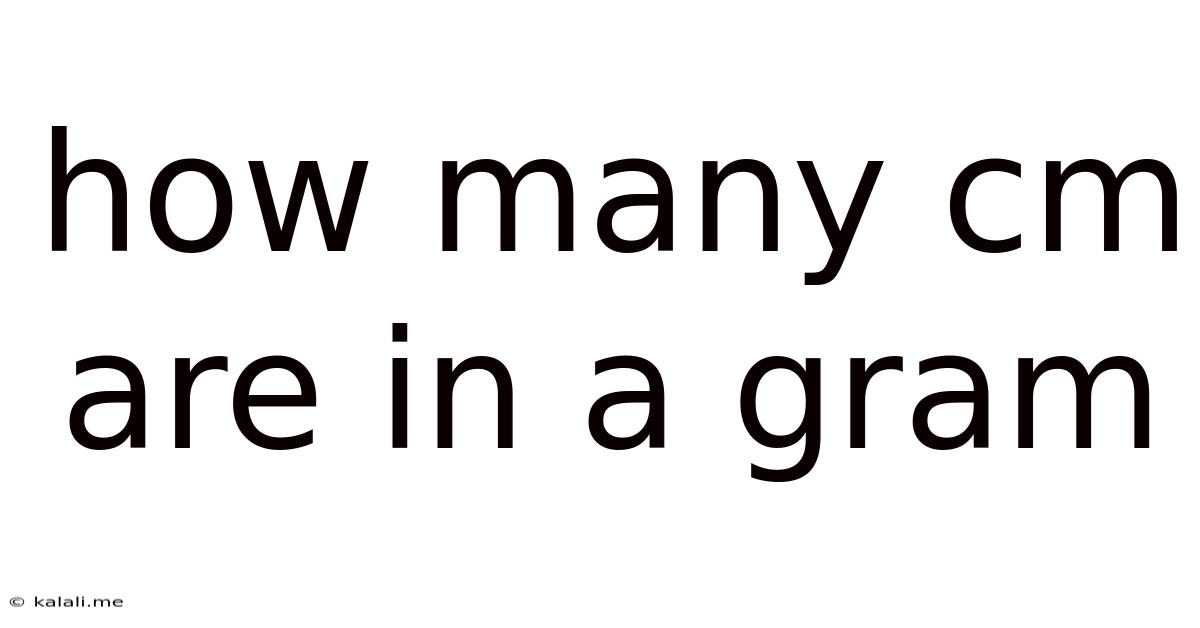How Many Cm Are In A Gram
Kalali
Jul 12, 2025 · 4 min read

Table of Contents
How Many Centimeters Are in a Gram? Understanding Units of Measurement
The question "How many centimeters are in a gram?" reveals a fundamental misunderstanding of units of measurement. Centimeters (cm) measure length or distance, while grams (g) measure mass or weight. They are fundamentally different physical quantities and therefore cannot be directly converted. This article will delve into the distinctions between these units, explore related concepts, and explain why a direct conversion is impossible. We will also touch upon common conversions involving mass and volume, offering a comprehensive understanding of metric system fundamentals.
Understanding the Difference: Length vs. Mass
Before we can even attempt to address the flawed premise of the question, we must clearly define the units involved.
-
Centimeter (cm): A unit of length in the metric system. One centimeter is equal to one-hundredth of a meter (1 cm = 0.01 m). It's used to measure the distance between two points, the length of an object, or the height of something. Think of measuring the length of a pencil, the width of a book, or the height of a person.
-
Gram (g): A unit of mass in the metric system. Mass is a measure of the amount of matter in an object. While often used interchangeably with weight (especially in everyday conversation), mass is distinct from weight. Weight is the force of gravity acting on an object's mass. A gram is a relatively small unit; a paperclip weighs approximately one gram. We use grams to measure the mass of food ingredients, small objects, or materials in scientific experiments.
The key takeaway here is that centimeters and grams measure completely different physical properties. Trying to convert one to the other is like trying to convert apples to oranges – it's simply not possible without additional information.
The Role of Density in Relating Mass and Volume
While we cannot directly convert grams to centimeters, we can relate mass (grams) to volume (cubic centimeters, cm³), provided we know the density of the material. Density is the mass per unit volume of a substance. The formula for density is:
Density (ρ) = Mass (m) / Volume (V)
This equation allows us to find the volume occupied by a given mass, or vice versa, if we know the density. Density is typically expressed in grams per cubic centimeter (g/cm³) or kilograms per cubic meter (kg/m³).
Example:
Let's say we have 10 grams of water. The density of water is approximately 1 g/cm³. Using the formula:
1 g/cm³ = 10 g / V
Solving for V (volume), we get:
V = 10 cm³
Therefore, 10 grams of water occupy a volume of 10 cubic centimeters. Note that this doesn't mean 10 grams equals 10 centimeters; it means 10 grams of water occupies a volume of 10 cubic centimeters. The relationship is contingent on the density of the substance. Different materials have different densities; gold, for example, is much denser than water, meaning 10 grams of gold would occupy a much smaller volume.
Other Relevant Conversions
To further illustrate the importance of understanding the different units, let's look at some common conversions within the metric system:
- Kilograms to Grams: 1 kilogram (kg) = 1000 grams (g)
- Meters to Centimeters: 1 meter (m) = 100 centimeters (cm)
- Liters to Cubic Centimeters: 1 liter (L) = 1000 cubic centimeters (cm³)
- Cubic Meters to Cubic Centimeters: 1 cubic meter (m³) = 1,000,000 cubic centimeters (cm³)
These conversions are all within the same system of units and are straightforward because they involve different units of the same physical quantity (mass or length). They are based on powers of 10, which is a key characteristic of the metric system, designed for easy conversion.
The Importance of Understanding Units in Science and Everyday Life
Understanding the difference between units like grams and centimeters is crucial for accurate measurements and calculations, particularly in scientific fields like physics, chemistry, and engineering. Inaccurate unit handling can lead to serious errors, with significant consequences in various applications. Furthermore, a grasp of unit conversion is essential for everyday tasks, from cooking (measuring ingredients) to construction (measuring materials).
Common Mistakes and Misconceptions
A common mistake is assuming that mass and volume are directly interchangeable. As explained above, this is only true if the density of the material is known. Another misconception is conflating weight and mass. While related, they are distinct concepts. Weight is affected by gravity, while mass remains constant regardless of gravitational pull.
Conclusion: Addressing the Initial Question
To reiterate, there is no direct conversion between centimeters and grams. They represent fundamentally different physical quantities: length and mass, respectively. Any attempt to convert between them requires knowledge of the density of the material being considered. The relationship is not a direct one-to-one conversion but rather involves calculating the volume occupied by a given mass using the density formula. Understanding this distinction is fundamental to correctly interpreting and using units of measurement in various contexts. Remember to always be mindful of the units involved in any calculation or measurement to avoid errors. Mastering the basics of the metric system will make calculations and conversions much easier and less prone to mistakes.
Latest Posts
Latest Posts
-
What Is Half Of 2 2
Jul 13, 2025
-
How Much Is 69 Kg In Pounds
Jul 13, 2025
-
5 6 Kg Is Equal To How Many G
Jul 13, 2025
-
What Does The C In React Represent Active Shooter
Jul 13, 2025
-
How Do You Measure 5 8 Cup
Jul 13, 2025
Related Post
Thank you for visiting our website which covers about How Many Cm Are In A Gram . We hope the information provided has been useful to you. Feel free to contact us if you have any questions or need further assistance. See you next time and don't miss to bookmark.